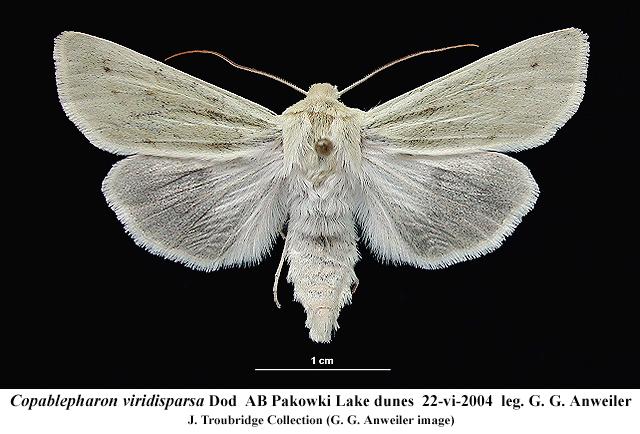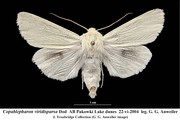« Back to your search
Species Details
Copablepharon viridisparsa
University of Alberta E.H. Strickland Entomological Museum Read more about this collection »
SeasonalityAdults have been collected in Alberta from late June to early August.
IdentificationA medium-size (3.8-4.2 cm wingspan) white moth with a faint grey-green cast caused by darker underlying scales and thus more pronounced in worn specimens. Frequently with a faint pale narrow vertical streak running from the base along the fold, and from the disc toward the apex. Rarely with a few fine black dots marking the antemedian and postmedian lines. The hindwings are white to light grey, always with at least some grey in the central area and at least some indication of a discal spot. Fringes white. The related C. grandis has pale yellow forewings and immaculate white hindwings lacking any trace of the dark discal spot. Protogygia pallida is very similar, but is dull white rather than greenish-white, the dark scaling on the hindwings is poorly defined and not concentrated in the central area, and the discal spot is lacking. Other white grassland moths have either prominent black spotting (i.e. Cucullia luna (Morr.)) or bright orange on the forelegs or venter (i.e. Hyphantria cunea (Drury), Spilosoma congrua Wlk.). The larvae are mostly cream in color, with a reddish tan dorsal stripe and a slightly darker stigmatal stripe; the ventral surface is distinctly blue (Seamans, 1925).
Scientific Name
Copablepharon viridisparsa
Habitat
Sand dunes and other disturbed sandy soils.
Seasonality
Adults have been collected in Alberta from late June to early August.
Identification
A medium-size (3.8-4.2 cm wingspan) white moth with a faint grey-green cast caused by darker underlying scales and thus more pronounced in worn specimens. Frequently with a faint pale narrow vertical streak running…
A medium-size (3.8-4.2 cm wingspan) white moth with a faint grey-green cast caused by darker underlying scales and thus more pronounced in worn specimens. Frequently with a faint pale narrow vertical streak running from the base along the fold, and from the disc toward the apex. Rarely with a few fine black dots marking the antemedian and postmedian lines. The hindwings are white to light grey, always with at least some grey in the central area and at least some indication of a discal spot. Fringes white. The related C. grandis has pale yellow forewings and immaculate white hindwings lacking any trace of the dark discal spot. Protogygia pallida is very similar, but is dull white rather than greenish-white, the dark scaling on the hindwings is poorly defined and not concentrated in the central area, and the discal spot is lacking. Other white grassland moths have either prominent black spotting (i.e. Cucullia luna (Morr.)) or bright orange on the forelegs or venter (i.e. Hyphantria cunea (Drury), Spilosoma congrua Wlk.). The larvae are mostly cream in color, with a reddish tan dorsal stripe and a slightly darker stigmatal stripe; the ventral surface is distinctly blue (Seamans, 1925).
Life History
The moths emerge from the pupae with the eggs nearly fully developed, and they are laid within a week or two. Eggs are laid in loose soil in mid-summer, and the larvae hibernate when partly grown, completing…
The moths emerge from the pupae with the eggs nearly fully developed, and they are laid within a week or two. Eggs are laid in loose soil in mid-summer, and the larvae hibernate when partly grown, completing development the following spring. They are one of the first noctuid larvae to become active in spring, are very active and can bury themselves very rapidly if uncovered. Feeding is above ground at night; during the day they bury themselves about 2.5 cm deep in the soil under the host plants. Pupation occurs in an earthen cell about five cm deep in the soil; adults emerge after three to four weeks. The pupae are unusual and distinctive in having an extremely long haustellum (proboscal sheath). Larval are parasitized by both Hymenoptera and Diptera, including the Tachnid fly Bonnetia compta Fall. (Seamans, 1925).
Conservation
A fairly rare and local species, found mainly in dunes.
Diet Info
The only recorded host is a native mustard (Cruciferae).
Range
In several subspecies from southern California and southern Utah north to southern BC, central Saskatchewan and southwestern Manitoba. In Alberta it occurs locally in the grasslands region of the southern half of the…
In several subspecies from southern California and southern Utah north to southern BC, central Saskatchewan and southwestern Manitoba. In Alberta it occurs locally in the grasslands region of the southern half of the province, west to Calgary and north to Wainwright. It was described by Dod from specimens from Lethbridge (the type locality) and Calgary.
References
Author
Seamans, H. L.
Title
Notes on the genus Copablepharon (Harvey) in Alberta.
Publication Date
1925
Series Title
The Canadian Entomologist
Volume
57
Pages
287-290
Author
Strickland, E. H.
Title
The Noctuid genus Copablepharon (Harvey) with notes on its taxonomic relationships
Publication Date
1920
Series Title
Psyche
Volume
27
Pages
81-85
Specimen Information
There are 268 specimens of this Species.
UASM117452 - Copablepharon viridisparsa
University of Alberta E.H. Strickland Entomological Museum
Place CollectedUnited States: Wyoming, Albany county
Collected ByFerris, C.
Date Collected2002-08-09
UASM117453 - Copablepharon viridisparsa
University of Alberta E.H. Strickland Entomological Museum
Place CollectedUnited States: Wyoming, Albany county
Collected ByFerris, C.
Date Collected2002-08-17
UASM117454 - Copablepharon viridisparsa
University of Alberta E.H. Strickland Entomological Museum
Place CollectedUnited States: Wyoming, Albany county
Collected ByFerris, C.
Date Collected2002-07-19
UASM117455 - Copablepharon viridisparsa
University of Alberta E.H. Strickland Entomological Museum
Place CollectedUnited States: Wyoming, Albany county
Collected ByFerris, C.
Date Collected2002-07-15
UASM117456 - Copablepharon viridisparsa
University of Alberta E.H. Strickland Entomological Museum
Place CollectedUnited States: Wyoming, Albany county
Collected ByFerris, C.
Date Collected2002-07-30
UASM117457 - Copablepharon viridisparsa
University of Alberta E.H. Strickland Entomological Museum
Place CollectedUnited States: Wyoming, Albany county
Collected ByFerris, C.
Date Collected2002-07-14
UASM117458 - Copablepharon viridisparsa
University of Alberta E.H. Strickland Entomological Museum
Place CollectedUnited States: Wyoming, Albany county
Collected ByFerris, C.
Date Collected2002-08-14
UASM117459 - Copablepharon viridisparsa
University of Alberta E.H. Strickland Entomological Museum
Place CollectedUnited States: Wyoming, Albany county
Collected ByFerris, C.
Date Collected2002-07-25
UASM117460 - Copablepharon viridisparsa
University of Alberta E.H. Strickland Entomological Museum
Place CollectedUnited States: California, Siskiyou county, Mount Shasta
Collected ByTroubridge, J.
Date Collected1998-09-15
UASM117461 - Copablepharon viridisparsa
University of Alberta E.H. Strickland Entomological Museum
Place CollectedUnited States: Washington, Douglas county, Bridgeport
Collected ByTroubridge, J.
Date Collected2001-06-08
UASM117462 - Copablepharon viridisparsa
University of Alberta E.H. Strickland Entomological Museum
Place CollectedUnited States: Washington, Douglas county, Bridgeport
Collected ByTroubridge, J.
Date Collected2001-06-08
UASM117463 - Copablepharon viridisparsa
University of Alberta E.H. Strickland Entomological Museum
Place CollectedUnited States: Washington, Douglas county, Bridgeport
Collected ByTroubridge, J.
Date Collected2001-06-08
UASM117464 - Copablepharon viridisparsa
University of Alberta E.H. Strickland Entomological Museum
Place CollectedUnited States: Washington, Douglas county, Bridgeport
Collected ByTroubridge, J.
Date Collected2001-06-08
UASM117465 - Copablepharon viridisparsa
University of Alberta E.H. Strickland Entomological Museum
Place CollectedUnited States: Washington, Douglas county, Bridgeport
Collected ByTroubridge, J.
Date Collected2001-06-08
UASM117466 - Copablepharon viridisparsa
University of Alberta E.H. Strickland Entomological Museum
Place CollectedUnited States: Washington, Douglas county, Bridgeport
Collected ByTroubridge, J.
Date Collected2001-06-08
UASM117467 - Copablepharon viridisparsa
University of Alberta E.H. Strickland Entomological Museum
Place CollectedUnited States: Washington, Douglas county, Bridgeport
Collected ByTroubridge, J.
Date Collected2001-06-08
UASM117468 - Copablepharon viridisparsa
University of Alberta E.H. Strickland Entomological Museum
Place CollectedUnited States: Washington, Douglas county, Bridgeport
Collected ByTroubridge, J.
Date Collected2001-06-08
UASM117469 - Copablepharon viridisparsa
University of Alberta E.H. Strickland Entomological Museum
Place CollectedUnited States: Washington, Douglas county, Bridgeport
Collected ByTroubridge, J.
Date Collected2001-06-08
UASM117470 - Copablepharon viridisparsa
University of Alberta E.H. Strickland Entomological Museum
Place CollectedUnited States: Washington, Douglas county, Bridgeport
Collected ByTroubridge, J.
Date Collected2001-06-08
UASM117471 - Copablepharon viridisparsa
University of Alberta E.H. Strickland Entomological Museum
Place CollectedUnited States: Washington, Douglas county, Bridgeport
Collected ByTroubridge, J.
Date Collected2001-06-08
UASM117472 - Copablepharon viridisparsa
University of Alberta E.H. Strickland Entomological Museum
Place CollectedUnited States: Washington, Douglas county, Bridgeport
Collected ByTroubridge, J.
Date Collected2001-06-08



